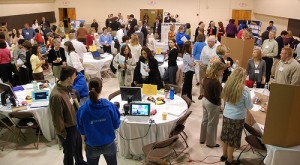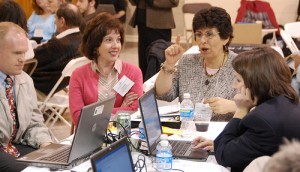By Mary Worrell
The ADVIS Cohort celebrated the end of its year-long PLP experience with a culminating, face-to-face meeting hosted by Springside School in Philadelphia earlier this month. The morning of the event was organized much like a science fair with teams presenting their projects at different tables and started with an hour of project exhibition.

For many ADVIS cohort team members, this is only the second time they’ve met face-to-face since beginning the PLP process a year ago. But the atmosphere couldn’t have been more different.
“The difference in the energy level and tone in the room relative to the first face-to-face was incredible,” said Stacey Kley, director of professional development for ADVIS. “They got to know each other online and it was like old friends getting together.”
After an hour of project exhibition, four teams presented their projects during the second half of the program.

“The energy and excitement in the room was palpable. There really was this great sense of sharing and excitement about the end product of the work the teams had done throughout the year,” said Barbara Kraus-Blackney, executive director of ADVIS. “Whereas at the first meeting, and even on some of the Elluminate sessions, there was a sense of wariness and fear. It came full circle. There was a great sense of trust and sharing and knowing each other even though, in most cases, people hadn’t seen each other face-to-face.”
Kraus-Blackney said there was a great comradarie going on not only among teams, but within teams.
“One thing that really struck me was the appreciation within a team of working together and getting to know each other on a level they wouldn’t have,” Kraus-Blackney said. “Some of our schools are quite large and might not have known each other so well.
ADVIS has decided to sign on for a second year one PLP cohort as well as a new, year two cohort.
“We’re looking for some leaders to come out of this,” Kraus-Blackney said. “It’s a great chance for them to have a place to be leaders and to contribute to other PLP communities and our second year one cohort as mentors.”
You can see more photos of the event here.
Each of the ADVIS teams developed culminating projects, most of which involve plans designed to bring the PLP experience to fellow faculty members and students. Four teams presented their projects to the attendees. Below are links to each school team’s wiki page and a brief description about the team’s concept in developing their project.
Abington Friends School
Abington has decided to use the PLP cohort model next year and beyond, with the goal of creating a professional learning community for the purpose of supporting the teaching of 21st century skills in the classroom. The current members will remain, and we have produced a video to invite and encourage others to join. You can read more about their project here.
Baldwin School
The projects developed by Baldwin’s team were both presentational (created by students) and representational (instructional “how tos” for faculty use). Through a Professional Development wiki , the team is setting the digital stage for dialogue on projects that are being done at Baldwin, along with instructions. You can read more about their project here.
Haverford School
Team Haverford kept a diary of the PLP experience on their wiki page and documented their project with multimedia presentations and video. Their project involves revising their curriculum to incoroprate 21st century skills and creating a learning community for faculty and students. You can read more about their project here.
Holy Child Academy
Holy Child started their project with the goals of introducing faculty and administrators to the importance of Web 2.0 tools as well as providing professional developoment opportunities. You can read more about their project here.
Montgomery School
Team Montgomery’s project focuses on getting parents supporting and using 21st century learning tools in an effort to empower the entire school community with the knowledge necessary to encourage students to become global citizens. You can read more about their project here.
Moravian Academy
You can read about Team Moravian’s project here. (Info wasn’t posted at the time of this posting. More description to come.)
Rosemont School of the Holy Child
Rosemont’s project is to design an ongoing professional development model that will help faculty explore the shifts in education and the impact of the collaborative and creative impact of technology while helping them to figure out how to take advantage of the unique potential of emerging tools and approaches. You can read more about their project here.
Doane Academy
As Doane Academy’s team began to brainstorm ideas for its project, a faculty member came to the team with a need for technology assistance for a student project that she was proposing for seventh grade. The project is the Challenge 20/20 Project, sponsored by NAIS. The program proposes 20 global issues, and teams of students from two to three schools collaborate to research a problem and develop ideas for ways that they can be part of a solution for their issue. The team decided to make helping with this the center of its project. You can read more about their project here
The Pilot School
You can read more about The Pilot School’s team project here. (Info wasn’t posted at the time of this posting. More description to come.)
Woodlynde School
Woodlynde focused its project efforts on raising awareness among its faculty of Web 2.0 tools and getting reachers excited about working with technology. The team decided to do this in a number of ways, from utilizing wikis and Google docts to tagging useful Web sites through Diigo. You can read more about their project here.
Wyoming Seminary
Team Wyoming created a wiki discussing different Web 2.0 tools and how teachers can use them. You can read more about their project here.
Friends School of Mullica Hill
The team’s main goal was to model and encourage the use of 21st Century skills and digital technologies in hopes of enabling teachers to develop a curriculum which includes skills students will need for the 21st Century and beyond. You can read more about their project here.
Benchmark School
Benchmark’s team project outlined plans for bringing web 2.0 professional development to the school. The project starts with a Technology Statement and a celebration of steps already taken this year, then focuses on assessing skills and building a training program, acquiring tools and increasing communication throughout the school. You can read more about Benchmark’s team project here.
The Hill School
The Hill School Team’s project dealt with making the school’s modern language classrooms more interactive with emerging technology. You can read more about their project here.
West Chester Friends School
The West Chester team developed its “Moon Base Project” with the goals of helping students learn to collaborate and utilize 21st century tools. You can read more about their project here.
Academy of Notre Dame
Team Notre Dame is developing a faculty professional development program that focuses on new and emerging Web 2.0 technologies. You can read more about their project here.
The Episcopal Academy
The team from Episcopal Academy created a Web site linking to learning communities for faculty and students. You can read more about their project here
Springside School
You can view two Springside videos here. You can read more about Springside’s team project here. (Info wasn’t posted at the time of this posting. More description to come.)
The Shipley School
Team Shipley’s project goals included building a sustainable, teacher-led, collaborative learning community to encourage teachers to improve their professional practice by making meaningful change in their teaching as well as to positively influence student learning. You can read more about their project here.
The King’s Christian School
The team from King’s Christian created a project with goals of introducing teachers to a mentoring program in the use of 21st century skills and technologies, preparing teachers to be mentors. You can read more about their project here.
Mary Worrell
Latest posts by Mary Worrell (see all)
- Australian Virtual Learning Showcase – Day 4 - July 30, 2009
- Australian Virtual Learning Showcase – Day 3 - July 29, 2009
- Australian Virtual Learning Showcase – Day 2 - July 28, 2009

